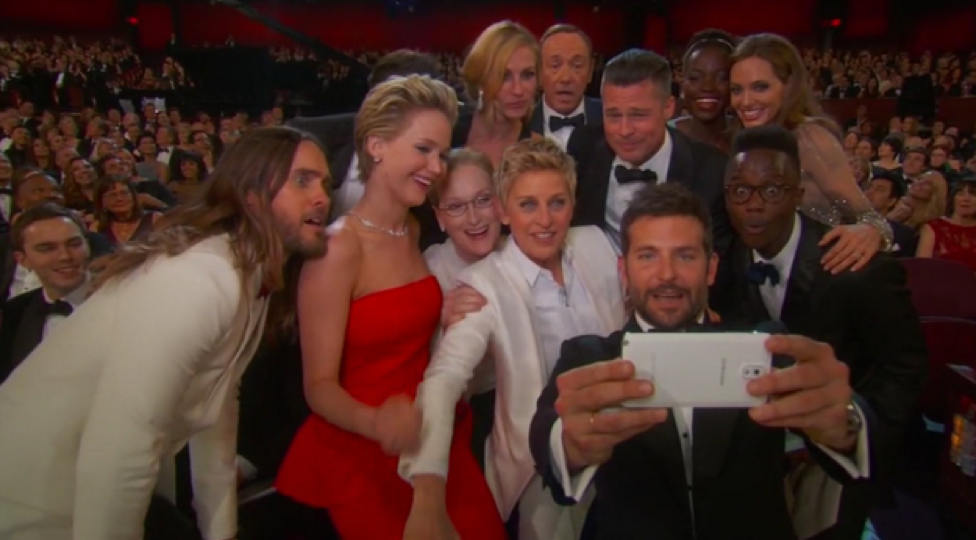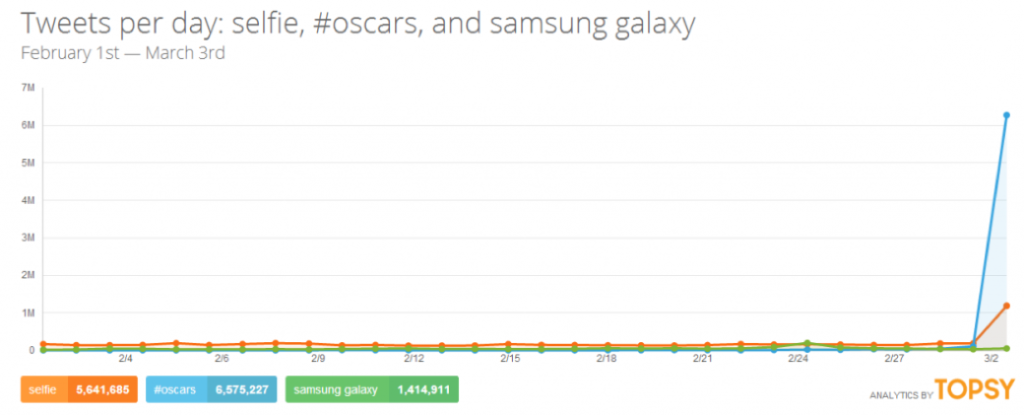
Photo Credit: AMPAS
The 86th Annual Academy Awards Oscars show last night came and went by for many people. However, for those of us that either love movies, celebrities, entertainment, and fashion it was the highlight of the year. If you are a marketing and advertising professional like I am, especially when it comes to digital and social media marketing, I was all eyes on how this moment was going to be owned by The Academy, advertisers, and second screen arm chair tweeters trying to capture a moment with RTM (Real Time Marketing).
The Oscars don’t have the viewership and ratings of a Super Bowl, however this year saw the highest ratings in more than a decade with an average of 43 million viewers. More importantly with the prolific use of celebrities within social media, this Awards show is tops for taking advantage of the moment beyond the 3 or so hours of the show. Ellen DeGeneres, the host of this year’s Oscars alone currently has 27 million followers on Twitter. A healthy base to spark social media conversation. Sure enough, one of her first efforts after her opening monologue was a ‘selfie’ on stage. Then came Pharrell and the “Arby’s Hat” on stage where Arby’s yet again seized the moment with a tweet of their own. Of course, came the epic “group selfie” where Ellen asked a group of A-listers to get together for a selfie to help break the record of most retweets which it promptly did during the show with currently over 2.8 MM retweets or 3x the retweets of the previous record holding tweet. It also momentarily broke Twitter.
…in order to win, marketers needs to thoroughly think of a second screen strategy first.
What was impressive was seeing the brands that took advantage of the socially cultural moment and didn’t rely only on their traditional media buy, but extended social integration. This continues to prove that in order to win, marketers needs to thoroughly think of a second screen strategy first.
Breakthrough brands…
Samsung Mobile, Cadillac, JCPenney, Lipton Tea were good examples of taking advantage of the moment. ABC Network unfortunately failed to win by having their live stream on mobile devices not working. I was one of those who watched the Red Carpet behind the scenes live stream on my tablet via the ABC app. About 30 minutes before the Oscars the stream stopped. I tried numerous times to reconnect and quickly realized from other people on Twitter that this wasn’t a single problem but common to others. The live stream didn’t work throughout the night.
The winning brands had the common thread of making sure that they not only paid for traditional advertising but had ongoing social and digital integration throughout thenight. A few key insights that I noticed to improve second screen first strategy is:
1. Ensure traditional media has clear tie to experiential social.
Samsung won the night with social conversation by a smart product placement of their new Galaxy devices and capturing the keywords “selfie”, “oscars” and “samsung galaxy”. Per a quick Topsy report, their mentions were all in the millions. However, how did that translate to the 90 second TV spot of “You Need To See This”. Currently, it has under 50,000 Youtube organic views the day after the event when people are searching for context of buzz.

There was no clear call to action on any of the TV spots (a total of 5 minutes worth of TV spots). If the objective of the marketing efforts was to be a part of the social consciousness during and after the moment, then it’s a win. If the goal was to get people talking about the Galaxy line of products or more directly the new Galaxy S 5 that was announced a few days ago. This fell through the noise.
2. Co-branding even if you’re not directly tied to the event.
What does Lipton Tea have to do with the red carpet? Nothing. However, when it is paired with conversational icons like the Muppets strutting their stuff on the red carpet and included in your TV ad buy. Lipton was now part of the story with the #BeMoreTea campaign. They also took advantage of some RTM with this post. One of the few examples of this working in contest of their effort.
Of course other brands tried to take advantage of Real Time Marketing with tweets that had nothing to do with the night and Denny’s didn’t fail to deliver a bad example by sharing this tweet.
At this point, as a brand why even bother? If you have a reason to engage with other efforts around an event then plan ahead and have a seat at the table. Don’t just barge in. It’s rude.
3. Quality vs Quantity engagement.
JCPenny had an innovative approach with Vine videos. If their objective was to engage directly with their existing customers and fan base then it seemed to have worked by extending the content into Twitter where they currently have almost 300,000 followers.
They engaged people via Vine and their “#GoldenMoment” contest. They received many entries via Vine however with minimal revines and likes. I’ve yet to see a successful video UGC contest that successfully acquires mass submissions due to the fact that there are so many barriers to entry. In the case of JCPenny you had to be a fan of their Twitter profile, have the Vine app, and the time to take a take video and post.
Within social engagements, finding the sweet spot of quality vs. quantity should always be the focus.
To wrap things up, it was refreshing to see that more and more socially driven advertisers are recognizing the need to think beyond traditional advertising and create unique second screen experiences while there is still opportunity to innovate and create unique moments for consumers to engage.
What was your favorite moment of the Oscars that you felt helped amplify traditional advertising?